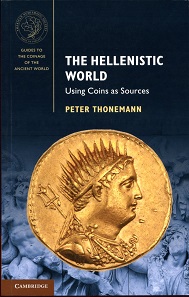by Ursula Kampmann
translated by Annika Backe
June 16, 2016 – There is something for which we can only envy the English historians: None of them is afraid of writing in such a plain way that is becomes comprehensible to everybody. The new book by Peter Thonemann, an introduction into the numismatics of the Hellenistic world, reads as if it was written with the intention of being read and not for learning, let alone to serve as an illustration of its author’s knowledge.
Peter Thonemann, The Hellenistic World – Using Coins as Sources. Cambridge University Press / ANS 2016. 260 p. with numerous black and white figs. 21 x 14 mm. Paperback. ISBN 9781107451759. 34.99 $.
Peter James Thonemann (*1978) really knows his way around the subject-matter, having written his first monograph on the Maeander valley in 2011, and doing much research on the history of Asia Minor ever since.
He is the first author of a new series that the ANS, in collaboration with Cambridge University Press, has initiated, with Andrew Meadows as editor. It is targeted at students and beginners who do not know anything yet about the covered topics. Without any previous knowledge in Hellenistic history, you can familiarize yourself with the current state of research and current research problems, only by reading this book.
To that end, this book does not arrange its material chronologically or geographically, but according to subject areas. The first part, under the modern keyword “Globalization”, nevertheless provides a kind of introduction into the Hellenistic period coming into being under Philip and Alexander, and the political units that you can consider part of the Hellenistic world.
Part 2 is called “Identity” and deals with two different fields of topics. The initial focus is placed on the coinages of the cities and city networks. It introduces the most important coin minting protagonists and explains why so many of those, in addition to their civic coins, also struck coins that were modeled on the Alexander type. The second focus is on all the non-Greek communities that, during the Hellenistic era, suddenly started to mint their own coins. This phenomenon can be encountered from the Parthians to Sicily.
Political Economy, as the heading of the third part reads, deals with the decisive questions as to who coined money why and when, and where it was circulating. The author is also interested in small change, the bronze coins that were so essential to everyday business life.
Bearing the title “Ideology”, the fourth part addresses the self-representation of the kings and queens and the reference the coins make to historical events. In a final chapter of this part a brief synopsis of the transition to the post-Hellenistic coinage is given.
Detailed tools for understanding, including annotated literature recommendations, a glossary of numismatic terms and the denomination system, a comprehensive bibliography and a detailed index make the book a useful tool.
We can only recommend this lavishly illustrated, appetite-stimulating written, weighty, 230 page book that provides a marvelous overview of Hellenistic coinage. It is such a good work that it makes you forgive the author his priggish side blows at past generations of researchers which were not that politically correct, ethnically open and intelligent as the current generation. The awareness that paradigms are changing and that you might be caught in your perception of the world just as much as others were before you, does not, after all, form part of the teaching material.
Here you may order the book.





